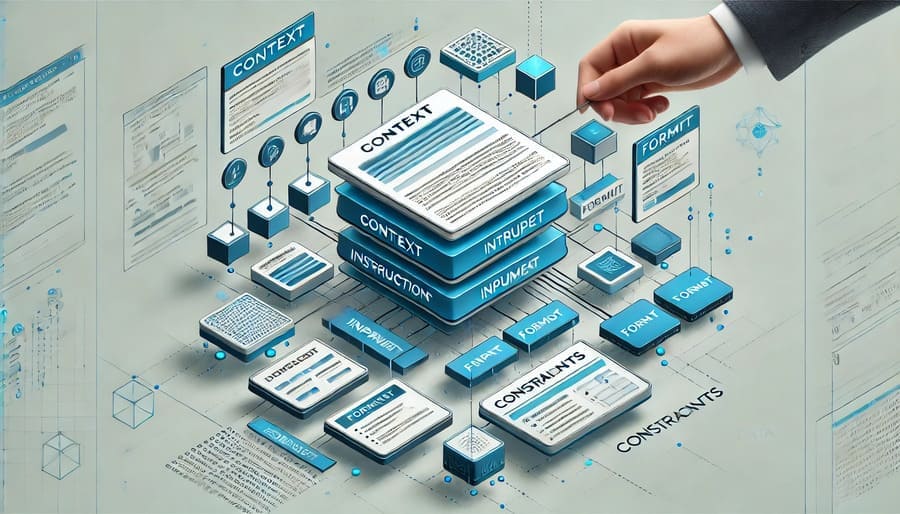Prompt Templates

Prompt templates have emerged as a critical tool for consistent, effective communication with AI systems. These structured frameworks provide a standardized approach to crafting prompts, ensuring reliability and precision across various AI interactions while significantly reducing the time and effort needed to achieve optimal results.
A prompt template is essentially a pre-designed structure for communicating with AI systems. It serves as a reusable pattern that defines the format, components, and overall organization of prompts for specific use cases. Think of it as a blueprint that standardizes how you frame requests to ensure consistent, high-quality outputs.
Unlike ad-hoc prompting, which relies on spontaneous formulation, templates provide a systematic approach that incorporates proven patterns and best practices. This standardization is particularly valuable in data engineering contexts, where consistency and reproducibility are paramount.
Most effective prompt templates include several key elements:
- Context Section: Establishes relevant background information
- Instruction Block: Clearly states what task to perform
- Input Placeholders: Designated areas for variable information
- Format Specification: Defines the expected output structure
- Examples Section: Demonstrates desired input-output patterns (optional)
- Constraints: Establishes boundaries and limitations (optional)
[CONTEXT]
You are analyzing data from a financial transaction system with the following schema: {schema_details}.
[INSTRUCTION]
Generate a SQL query that will {task_description}.
[INPUT]
Data requirements: {specific_data_needs}
Time period: {time_period}
[OUTPUT FORMAT]
Return valid SQL code without explanation, optimized for {database_type}.
[CONSTRAINTS]
- Query should not use any temporary tables
- Must include appropriate indexing hints
- Should handle NULL values explicitly
Templates ensure that similar tasks produce consistent results regardless of who creates the prompt. This standardization is particularly valuable in team environments where multiple people interact with AI systems.
Once developed, templates dramatically reduce the time needed to craft effective prompts. Data engineers can focus on the specific parameters rather than redesigning the prompt structure for each interaction.
Templates serve as documentation of institutional knowledge about effective AI interactions. New team members can quickly adopt proven approaches rather than learning through trial and error.
By incorporating best practices and avoiding known pitfalls, templates establish a quality baseline for AI interactions, reducing the likelihood of suboptimal outputs.
Templates provide a stable foundation that can be systematically improved over time, with enhancements benefiting all future uses of the template.
[CONTEXT]
Source data format: {source_format}
Target data format: {target_format}
Transformation purpose: {purpose}
[INSTRUCTION]
Design a data transformation process that converts the source data to the target format.
[INPUT]
Sample source data:
{sample_data}
[OUTPUT FORMAT]
Provide:
1. Transformation logic in {language} code
2. Handling for edge cases
3. Data validation steps
[CONSTRAINTS]
- Must handle missing or malformed data
- Should preserve data fidelity
- Must be performant for datasets up to {size}
[CONTEXT]
You are reviewing a proposed data architecture for {use_case}.
[INSTRUCTION]
Evaluate the following design, identifying strengths, weaknesses, and potential improvements.
[INPUT]
Architecture description:
{architecture_details}
Requirements:
{key_requirements}
[OUTPUT FORMAT]
Provide a structured analysis covering:
1. Scalability assessment
2. Data governance implications
3. Technical debt considerations
4. Alternative approaches
5. Recommended improvements
[EVALUATION CRITERIA]
- Alignment with business requirements
- Technical feasibility
- Cost efficiency
- Maintenance complexity
[CONTEXT]
You are diagnosing an issue in a data pipeline.
[INSTRUCTION]
Analyze the following error and suggest potential causes and solutions.
[INPUT]
Error message:
{error_message}
System context:
{system_details}
Recent changes:
{change_log}
[OUTPUT FORMAT]
Provide:
1. Likely root causes (in order of probability)
2. Diagnostic steps to confirm each cause
3. Recommended solutions for each scenario
- Identify Common Patterns: Review successful prompts to identify recurring elements
- Extract the Structure: Separate fixed elements from variable components
- Parameterize Variables: Replace specific details with clearly named placeholders
- Add Metadata: Include context and usage guidance
- Test and Refine: Validate the template across multiple scenarios
- Document Best Practices: Note optimal ways to fill in variable components
For organizations working extensively with AI systems, consider these approaches to template management:
- Template Libraries: Maintain a centralized repository of proven templates
- Version Control: Track template evolution and improvements
- Categorization System: Organize templates by use case and complexity
- Annotation: Document the rationale behind template design choices
- Performance Metrics: Track the effectiveness of different templates
Build modular templates that can be combined for complex tasks:
[INCLUDE: authentication_context]
[INCLUDE: data_validation_block]
[INCLUDE: performance_constraints]
[INSTRUCTION]
Create a data pipeline component that {specific_task}.
Design templates that adjust based on initial AI responses:
[INITIAL INSTRUCTION]
Analyze this dataset and identify the most notable patterns.
[CONDITIONAL BLOCK: If patterns include temporal anomalies]
Perform a time-series decomposition focusing on the seasonal components.
[CONDITIONAL BLOCK: If patterns include clustering]
Identify optimal cluster boundaries using these criteria: {criteria}.
Create templates designed for collaboration between multiple AI systems:
[AGENT 1: Data Analyst]
Analyze the following data and identify key insights: {data}
[AGENT 2: Business Translator]
Take the technical insights provided by Agent 1 and reformulate them in business terms relevant to the {industry} sector.
[COORDINATION INSTRUCTION]
Agent 1 should focus on statistical significance while Agent 2 should prioritize actionable recommendations.
Problem: Creating excessively rigid templates that limit AI creativity and problem-solving. Solution: Balance structure with flexibility, particularly in sections addressing complex reasoning.
Problem: Templates that grow increasingly complex and unwieldy over time. Solution: Regularly refactor templates to maintain clarity and focus; split complex templates into modular components.
Problem: Unclear transitions between template sections leading to mixed instructions. Solution: Use clear section dividers and consistent formatting to maintain logical separation.
Problem: Vague or confusing placeholder names leading to incorrect substitutions. Solution: Use descriptive, specific placeholder names with example values as guidance.
Prompt templates represent a crucial evolution in AI interaction—moving from improvised communication to systematic, optimized approaches. By developing and refining templates for common data engineering tasks, organizations can dramatically improve consistency, efficiency, and effectiveness in their AI operations. As AI capabilities continue to expand, well-designed prompt templates will serve as a foundational element of successful implementation strategies.
#PromptTemplates #AIStandardization #PromptEngineering #DataEngineeringAI #AIFrameworks #StructuredPrompting #TemplateDesign #AIInteraction #ConsistentAI #PromptOptimization